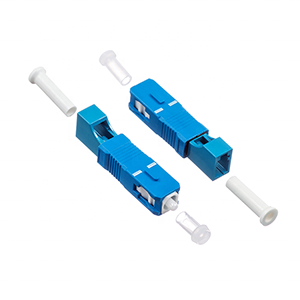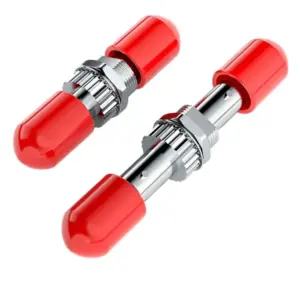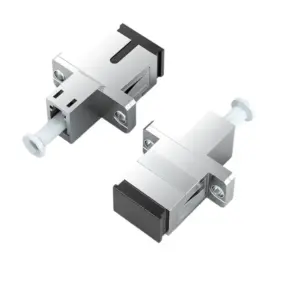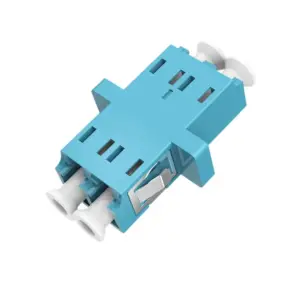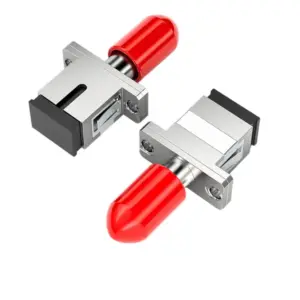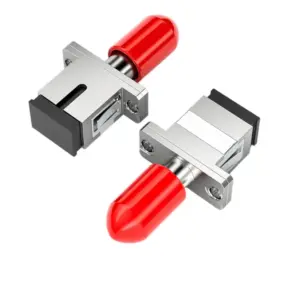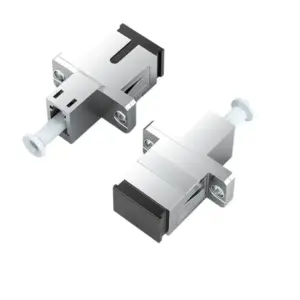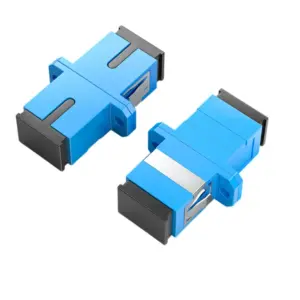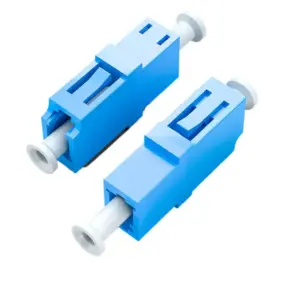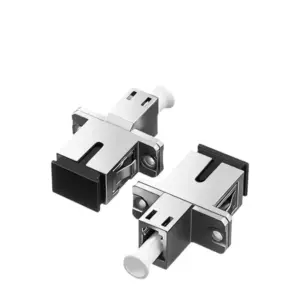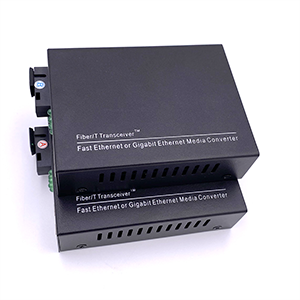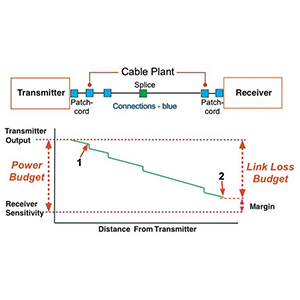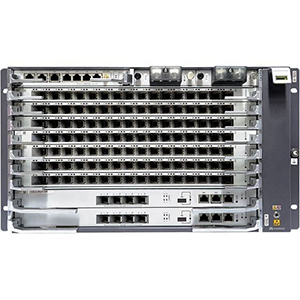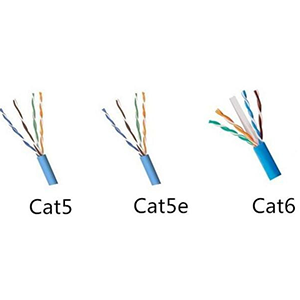Hello everyone! Today I am very happy to introduce to you a product that plays an important role in fiber optic communication systems – SC to LC adapter. As a key component for realizing different types of optical fiber connections, SC to LC adapters provide you with flexible and convenient connection solutions to help you build an efficient optical fiber network. In this article, I will introduce you to the definition, functional characteristics and wide range of application scenarios of this adapter in detail. I believe you will be very interested in it.
Basic overview of sc to lc adapter
SC to LC adapter is a fiber optic connector adapter used to connect two different types of fiber optic connectors, SC (Subscriber Connector) and LC (Lucent Connector). It provides a physical interface so that SC and LC connectors can be connected to each other.
The principle of the adapter is to realize the connection by providing interfaces corresponding to SC and LC connectors inside the adapter. Usually, the SC to LC adapter has one SC slot. The SC to LC adapter is an adapter used to connect two different types of fiber optic connectors, SC (Subscriber Connector) and LC (Lucent Connector). It provides a physical interface so that SC and LC connectors can be connected to each other.
The principle of SC to LC adapter is to realize the connection by providing interfaces corresponding to SC and LC connectors inside the adapter. Typically, an adapter has an SC slot on one end and an LC slot on the other, allowing the SC and LC connectors to plug into the corresponding slots on the adapter. The internal adaptation structure ensures that optical signals can be transmitted and converted correctly to achieve interconnection between different connector types.
In fiber optic communication systems, SC to LC adapters play an important role and have multiple applications:
Compatibility and interconnectivity: Since SC and LC connectors are commonly used fiber optic connector types, they are widely used in different systems and devices. SC to LC adapters provide a convenient solution that allows different connector types to connect and communicate with each other.
Flexibility and scalability: In fiber optic networks, when SC and LC connectors need to be connected, using adapters can avoid the need to replace the entire connector or fiber optic cable. Adapters provide a flexible way to adapt the system to different types of connector requirements and facilitate network expansion and upgrades.
Network connection and patch cord management: In fiber optic networks, SC to LC adapters can be used to achieve direct connections or patch cord connections between different devices. The use of adapters simplifies fiber optic cabling and management, making network installation and maintenance more convenient.
Device compatibility: Some devices may only support specific types of fiber optic connectors, while other devices may use different types of connectors. SC to LC adapters provide a bridging solution that enables these devices to connect and communicate with each other without having to replace connectors or devices.
In summary, SC to LC adapter plays an important role in fiber optic communication systems, providing a convenient and flexible solution for connecting and interconnecting the physical interface between SC and LC connectors. The use of adapters can simplify the management and maintenance of optical fiber networks and improve the flexibility and scalability of the system.
Introduction to the characteristics of sc to lc adapter types
SC to LC adapters come in many types, including single-mode and multi-mode adapters. The following is a detailed introduction, characteristics, applicable scenarios and performance parameters of each type of adapter:
Single mode adapter:
- Features: Single-mode adapters are used to connect single-mode fiber optic connectors, usually with a blue shell. They use 9/125 micron single-mode fiber, which is suitable for long-distance transmission and high-speed data transmission.
- Applicable scenarios: Single-mode adapters are suitable for long-distance communications and high-speed network applications with single-mode fiber optic connectors, such as fiber optic backbone networks, wide area networks (WAN), and data center interconnections.
- Performance parameters: The key performance parameters of single-mode adapters include insertion loss and return loss. Insertion loss is typically below 0.2 dB and return loss is above 50 dB.
Multimode adapter:
- Features: Multimode adapters are used to connect multimode fiber optic connectors, usually with gray or green housings. They use 50/125 micron or 62.5/125 micron multi-mode optical fiber, which is suitable for short-distance transmission and lower-speed data transmission.
- Applicable scenarios: Multi-mode adapters are suitable for local area networks (LAN) and short-distance communication applications, such as optical fiber connections within enterprise networks, data centers and smart buildings.
- Performance parameters: Key performance parameters of multimode adapters also include insertion loss and return loss. Insertion loss is usually below 0.2 dB and return loss is above 20 dB.
The insertion loss and return loss of an adapter are important indicators to measure its performance:
- Plug and unplug loss: Plug and unplug loss refers to the signal loss caused when inserting or unplugging a fiber optic connector on an adapter. Lower plug-in loss means that the adapter connection is stable and the signal transmission loss is small, which should usually be controlled below 0.2 dB.
- Return loss: Return loss refers to the signal return caused by the reflection or scattering of the optical signal inside the adapter. A higher return loss indicates better performance of the adapter as it reduces signal bounce and improves signal transmission quality, which should typically be above 50 dB.
It is important that when selecting an SC to LC adapter, you should choose the correct adapter type (single-mode or multi-mode) based on actual application needs and pay attention to performance parameters to ensure that the adapter’s compatibility and performance meet system requirements. In addition, it is also important to choose an adapter brand and manufacturer with good quality and reliability to ensure its long-term stable operation and reliability.
What are the application fields of sc to lc adapter
SC to LC adapters have a wide range of application cases in different fiber optic connection scenarios. Here are some common applications in data centers, enterprise networks, and telecommunications:
Data center applications:
- Fiber optic patch cord connections: In data centers, a large number of fiber optic patch cord connections are necessary to connect servers, storage devices and network equipment. When equipment in the data center uses different types of fiber optic connectors (such as SC and LC), SC to LC adapters provide a convenient solution, making direct connections between different connectors possible.
- System upgrades and expansions: When performing system upgrades or expansions in the data center, using SC to LC adapters enables fiber optic connections between existing equipment and new equipment without replacing the entire fiber optic cable or equipment. This flexibility and convenience allows data centers to easily upgrade and expand their fiber optic network architecture.
Enterprise network applications:
- Cross-floor connections: Enterprise networks often require network cabling across multiple floors. In this case, fiber optic connections between different floors may require different types of connectors. SC to LC adapters allow direct connection between different connectors, simplifying the management and maintenance of cross-floor fiber optic cabling.
- Network device connections: Network devices in corporate networks often use different types of fiber optic connectors. SC to LC adapters enable different types of devices to connect and communicate, providing flexibility and interconnectivity, simplifying the deployment of network devices and connection management.
Applications in telecommunications:
- Optical fiber communication network: In the field of telecommunications, optical fiber communication network is a critical infrastructure. Since different vendors and devices may use different types of fiber optic connectors, SC to LC adapters play an important role in the deployment and maintenance of fiber optic networks. It allows interconnection between different types of connectors, making fiber optic connections between devices more flexible and convenient.
- Network upgrade and maintenance: Telecom operators often need to upgrade and maintain their networks. SC to LC adapters can be used to connect fiber optic connections between new and old equipment, facilitating network upgrades and maintenance, and reducing cost and time overhead.
In summary, SC to LC adapters have a wide range of applications in data centers, enterprise networks, and telecommunications. It provides flexibility, convenience and interconnectivity, simplifying the management and maintenance of fiber optic connections and providing a cost-effective solution for system upgrades and expansions.
How to install and maintain sc to lc adapter
Here are some key steps and considerations when installing and maintaining the SC to LC adapter:
Installation steps:
- Step 1: Make sure the adapter and connector types match, such as SC adapter to SC connector, LC adapter to LC connector.
- Step 2: Clean the end face of the fiber optic connector to ensure its surface is clean and free of contaminants.
- Step 3: Insert the connector into the adapter’s port, making sure it is fully inserted and secure.
- Step 4: Make sure the adapter is firmly connected and avoid looseness or shaking.
The importance of protecting adapters:
- Avoid physical damage: Protect the adapter from physical damage and avoid hitting, twisting or bending the adapter.
- Prevent dust and contamination: Keep the adapter’s ports and connectors clean to avoid dust, grease, and other contaminants from entering the adapter, which may affect optical signal transmission and connection quality.
- Prevent bending of optical fiber: Ensure that the optical fiber is not excessively bent near the adapter to avoid optical signal loss and breakage.
Troubleshooting and repair methods:
- Plug and unplug check: Check whether the plug and pull between the adapter and connector is stable. If there is a loose or bad connection, reseat and make sure it is seated.
- Cleaning inspection: Regularly clean the end faces of adapters and connectors to ensure they are clean and free of contaminants. Use appropriate cleaning tools and avoid using rough materials or damaged cleaning tapes.
- Replacement check: If the adapter is damaged or faulty, consider replacing it with a new one. Avoid using adapters that are worn, damaged, or perform poorly.
For more complex troubleshooting and repairs, it is recommended to seek professional help, such as experienced fiber optic technicians or network engineers. These professionals can perform more in-depth troubleshooting, using fiber optic test instruments and equipment to diagnose problems and provide appropriate solutions.
In summary, properly installing and protecting the SC to LC adapter is key to ensuring good connection quality and system performance. Regularly inspecting and maintaining the adapter and following correct installation steps and precautions can extend the service life of the adapter and ensure the reliability and stability of the fiber optic connection.
Summary
As an essential accessory in the field of optical fiber communications, the SC to LC adapter shows its advantages in various application scenarios with its excellent performance and wide compatibility. Whether you are in the data center, enterprise network or telecommunications field, this adapter can provide a stable and reliable fiber optic connection solution, greatly improving the flexibility and scalability of the system.
We provide fiber optic adapter products with a variety of specifications and performances to meet your needs in different application environments. If you have any questions or needs about this product, please feel free to contact us at any time. Let us work together to build an efficient and stable optical fiber communication network and promote the development of digital transformation!
SC to LC Adapter FAQ
SC and LC connectors are two different types of fiber optic connectors. The main difference lies in their size and design. SC connectors have a square shape and a push-pull mechanism, while LC connectors have a smaller form factor with a latch-type mechanism.
The primary purpose of using an SC to LC adapter is to connect fiber optic cables with SC and LC connectors when different connector types are involved. It eliminates the need for re-terminating or replacing cables, providing a cost-effective solution for interconnecting different equipment or devices.
Yes, SC to LC adapters are compatible with both single-mode and multimode fibers. The adapters do not affect the fiber type compatibility, as they primarily serve as a physical connection interface between the SC and LC connectors.
SC to LC adapters introduce a minimal amount of insertion loss, typically around 0.2 to 0.5 decibels (dB). This loss is negligible and should not significantly affect signal quality or performance in most applications.
Yes, SC to LC adapters can be used in high-speed or high-bandwidth applications. They are designed to maintain the signal integrity and performance of the fiber optic connection, allowing for reliable transmission of data at various speeds and bandwidths.
Yes, there are different types of SC to LC adapters available to suit various installation requirements. Some common types include simplex adapters (single fiber), duplex adapters (two fibers), and hybrid adapters (SC on one end and LC on the other).
While SC to LC adapters can be used for temporary connections, they are generally not recommended for permanent installations. It is recommended to use fiber optic patch cords or pigtails with the desired connector types for permanent connections, as they provide more reliable and durable connections.
Yes, SC to LC adapters can be used for both single-mode and multimode applications. The compatibility primarily depends on the fiber type and the connectors being used. It is important to ensure that the adapters and cables used are compatible with the intended fiber type.
SC to LC adapters are commonly used in various applications, including telecommunications networks, data centers, enterprise networks, fiber optic test and measurement setups, and equipment interconnections. They provide flexibility in connecting different devices or components with SC and LC interfaces.

